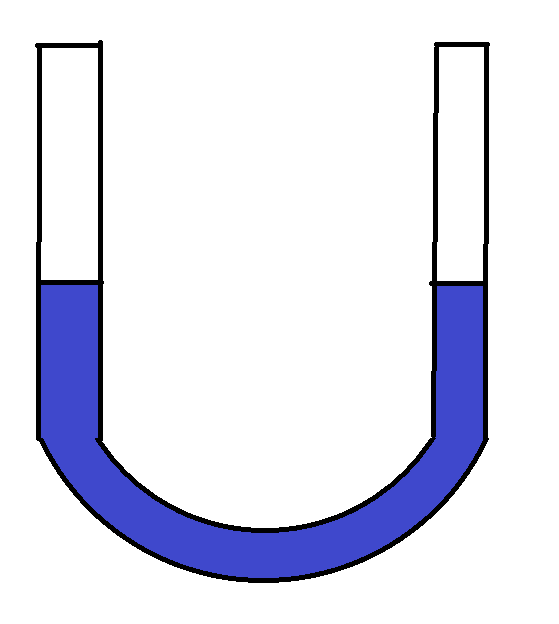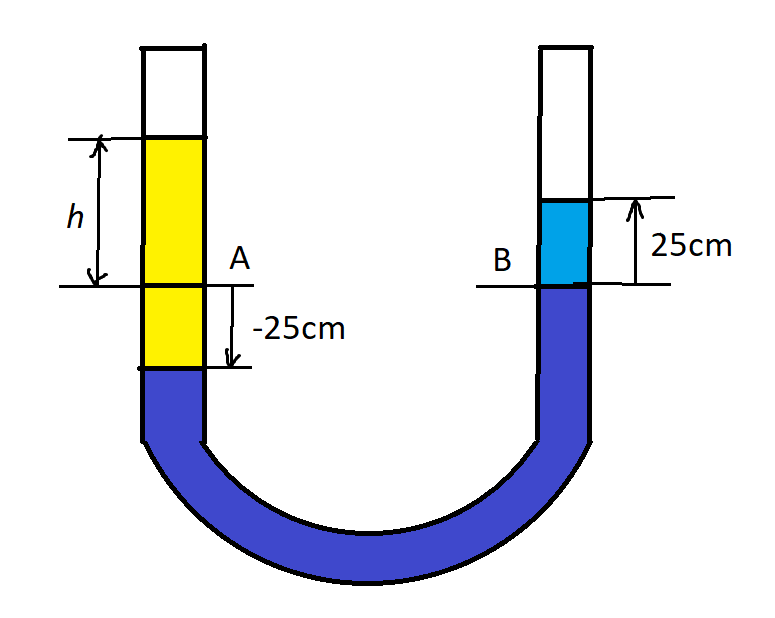
A U-tube is partially filled with water. Oil, which does not mix with water, is next poured into one side until water rises by 25 cm on the other side, if the specific gravity of oil be 0.8, the oil level will stand higher than the water level by:
A. 6.25 cm
B. 12.50 cm
C. 31.25 cm
D. 62.50 cm
Answer
574.8k+ views
Hint: Manometer is a device used for measuring the pressure in liquids. One of the most common types of manometers are called U-tube manometers which consist of a U-shaped tube. The pressure is calculated by measuring the height difference between the two limbs of the manometer.
Complete step by step answer:
Let us consider a U-tube manometer partially filled with water, as shown:

When oil is added to one side, the water on the other limb rises by 25 cm as shown.

Let h be the height to which the oil is filled.
If the level of water in one end rises by 25 cm at point B, the water level in the other end decreases by 25 cm at point A when the oil is added on top of it.
At the points A and B, the pressure will be equal.
Pressure at A = Pressure at B
${P_A} = {P_B}$
Pressure at point A,${P_A} = {\rho _{oil}} \times g \times (h + 25)$
Pressure at point B,${P_B} = {\rho _{water}} \times g \times 25$
Equating, we get –
${\rho _{oil}} \times g \times (h + 25)$= ${\rho _{water}} \times g \times 25$
Given, specific gravity of oil = 0.8
Specific gravity, $\dfrac{{{\rho _{oil}}}}{{{\rho _{water}}}} = 0.8$
\[
{\rho _{oil}} \times{g} \times (h + 25) = {\rho _{water}} \times {g} \times 25 \\
\dfrac{{{\rho _{oil}}}}{{{\rho _{water}}}} \times (h + 25) = 25 \\
Substituting, \\
0.8 \times (h + 25) = 25 \\
\Rightarrow (h + 25) = \dfrac{{25}}{{0.8}} \\
\Rightarrow h + 25 = 31.25 \\
\Rightarrow h = 31.25 - 25 \\
\Rightarrow h = 6.25cm \\
\]
Thus, the correct option is Option A.
Note: When the manometer is used to measure the pressure, the pressure, so recorded, is called absolute pressure. This pressure includes the atmospheric pressure. Now, if we subtract the atmospheric pressure from the absolute pressure, we get something called as gauge pressure.
Complete step by step answer:
Let us consider a U-tube manometer partially filled with water, as shown:

When oil is added to one side, the water on the other limb rises by 25 cm as shown.

Let h be the height to which the oil is filled.
If the level of water in one end rises by 25 cm at point B, the water level in the other end decreases by 25 cm at point A when the oil is added on top of it.
At the points A and B, the pressure will be equal.
Pressure at A = Pressure at B
${P_A} = {P_B}$
Pressure at point A,${P_A} = {\rho _{oil}} \times g \times (h + 25)$
Pressure at point B,${P_B} = {\rho _{water}} \times g \times 25$
Equating, we get –
${\rho _{oil}} \times g \times (h + 25)$= ${\rho _{water}} \times g \times 25$
Given, specific gravity of oil = 0.8
Specific gravity, $\dfrac{{{\rho _{oil}}}}{{{\rho _{water}}}} = 0.8$
\[
{\rho _{oil}} \times{g} \times (h + 25) = {\rho _{water}} \times {g} \times 25 \\
\dfrac{{{\rho _{oil}}}}{{{\rho _{water}}}} \times (h + 25) = 25 \\
Substituting, \\
0.8 \times (h + 25) = 25 \\
\Rightarrow (h + 25) = \dfrac{{25}}{{0.8}} \\
\Rightarrow h + 25 = 31.25 \\
\Rightarrow h = 31.25 - 25 \\
\Rightarrow h = 6.25cm \\
\]
Thus, the correct option is Option A.
Note: When the manometer is used to measure the pressure, the pressure, so recorded, is called absolute pressure. This pressure includes the atmospheric pressure. Now, if we subtract the atmospheric pressure from the absolute pressure, we get something called as gauge pressure.
Recently Updated Pages
Why are manures considered better than fertilizers class 11 biology CBSE

Find the coordinates of the midpoint of the line segment class 11 maths CBSE

Distinguish between static friction limiting friction class 11 physics CBSE

The Chairman of the constituent Assembly was A Jawaharlal class 11 social science CBSE

The first National Commission on Labour NCL submitted class 11 social science CBSE

Number of all subshell of n + l 7 is A 4 B 5 C 6 D class 11 chemistry CBSE

Trending doubts
What is meant by exothermic and endothermic reactions class 11 chemistry CBSE

10 examples of friction in our daily life

One Metric ton is equal to kg A 10000 B 1000 C 100 class 11 physics CBSE

1 Quintal is equal to a 110 kg b 10 kg c 100kg d 1000 class 11 physics CBSE

Difference Between Prokaryotic Cells and Eukaryotic Cells

What are Quantum numbers Explain the quantum number class 11 chemistry CBSE




